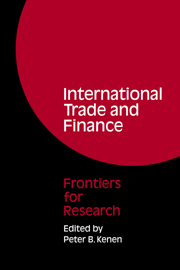Book contents
- Frontmatter
- Contents
- List of Contributors
- Preface
- PART I TRADE, PROTECTION, AND DOMESTIC PRODUCTION
- PART II ECONOMETRIC MODELS OF TRADE AND PAYMENTS
- Part III PAYMENTS ADJUSTMENT AND THE MONETARY SYSTEM
- Adjustment under Fixed and Flexible Exchange Rates
- International Reserves and Liquidity
- The LINK Model of World Trade, with Applications to 1972–73
- Discussion
- PART IV AN OVERVIEW AND AGENDA
- Glossary of Frequently Used Acronyms
- Author Index
Discussion
Published online by Cambridge University Press: 05 November 2011
- Frontmatter
- Contents
- List of Contributors
- Preface
- PART I TRADE, PROTECTION, AND DOMESTIC PRODUCTION
- PART II ECONOMETRIC MODELS OF TRADE AND PAYMENTS
- Part III PAYMENTS ADJUSTMENT AND THE MONETARY SYSTEM
- Adjustment under Fixed and Flexible Exchange Rates
- International Reserves and Liquidity
- The LINK Model of World Trade, with Applications to 1972–73
- Discussion
- PART IV AN OVERVIEW AND AGENDA
- Glossary of Frequently Used Acronyms
- Author Index
Summary
ADJUSTMENT UNDER FIXED AND FLEXIBLE EXCHANGE RATES: A COMMENT
The copious theoretical research on macroeconomic policy in the open economy has finally begun to induce some empirical work. One line of research, represented by Michaely (1971), explores the way in which governments actually manipulate their policy instruments in response to the signals of external and internal balance. Another undertakes to compute the effects a government can expect when it pulls on a policy lever. Helliwell summarizes the extant research on Canada of the latter type, leaping from a selective summary of the underlying policy theory to parametric revelations about our Northern Neighbor. Following the spirit of his paper, I shall comment on several aspects of the interplay of theory and empirical research in this obviously important area.
The underlying policy theory is in comparative-static form, whereas empirical estimates of policy leverages can hardly ignore the explicit time path of adjustment. The conventional methods of handling large-scale models yield estimates of ultimate effects, of course. But, aside from verifying the stability of the system, these hardly hold much interest for policy makers, who want to know the effect their handiwork will have by the next election. The results summarized by Helliwell derive from time-explicit simulations, as they should. But many model builders seem disinclined to devote great efforts to assuring that the short-run dynamics of the key relations have been captured as accurately as possible.
- Type
- Chapter
- Information
- International Trade and FinanceFrontiers for Research, pp. 485 - 500Publisher: Cambridge University PressPrint publication year: 1976



